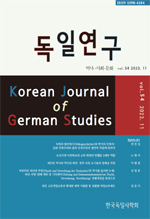독일인의 피난과 추방(Flucht und Vertreibung der Deutschen)의 역사를 둘러싼 논쟁: 피난·추방·화해 재단 및 기록센터(Stiftung und Dokumentationszentrum Flucht, Vertreibung, Versöhnung) 설립과정을 중심으로
Debates on the History of Flight and Expulsion of Germans: Focusing on the Establishment of the Foundation and Documentation Centre for Displacement, Expulsion, Reconciliation
- 23

본 연구는 제2차 세계대전 종전 무렵부터 시작된 독일인의 피난과 추방(Flucht und Vertreibung der Deutschen)을 기념하는 문제를 둘러싼 독일 통일 이후의 정치적·학술적 논쟁을 다룬다. 1990년대 독일의 두 거대 정당인 기민련과 사민당은 ‘피난’과 ‘추방’의 ‘희생자들’을 기억해야할 뿐만 아니라 전후 독일의 재건에 기여한 실향민들의 공로를 기려야 한다고 보았다. 독일인 강제이주에 대한 정치적 환기는 유고슬라비아 전쟁에서 발생한 ‘인종청소(ethnische Säuberung)’ 문제가 대두되는 과정에서 이루어졌다. 실향민연맹은 2000년부터 인권침해를 야기하는 ‘강제추방’을 배격한다는 명분하에 독일의 사례를 포함한 유럽의 피난과 추방의 역사를 기념하는 정보·기록보관소인 ‘강제추방반대센터(Zentrum gegen Vertreibungen)’를 베를린에 설립하려 하였다. 이러한 아이디어를 적극적으로 받아들인 메르켈 총리는 사민당과의 합의를 거쳐 ‘피난’과 ‘추방’을 기념하는 사업을 국가적 규모로 확장시켰다. 이 사업을 주관하는 피난·추방·화해 재단(Stiftung Flucht, Vertreibung, Versöhnung)이 2008년에 설립되었으며 2021년에는 피난·추방·화해 기록센터(Dokumentationszentrum Flucht, Vertreibung, Versöhnung)가 개관하였다. 기록센터 건립 과정에서 재단의 운영뿐만 아니라 센터의 상설전시 구상을 둘러싼 실향민연맹 측의 재단 내 인사들과 학술자문단 간의 갈등이 발생하였다. 쟁점은 독일인의 희생을 강조하는 과정에서 빚어지는 나치 범죄의 상대화와 그 해결에 관한 문제였다. 이러한 양측의 갈등 끝에 기록센터 상설전시관에서는 유럽사의 틀 안에서 독일인 강제이주 문제를 다루게 되었을 뿐만 아니라 나치의 팽창정책과 독일인의 추방 사이의 인과관계를 밝혀 놓게 되었다. 그러나 현재의 기록센터의 전시방식은 나치 범죄의 상대화에 대한 우려를 완전히 해소시키지 못하며 독일 국민들의 나치에 대한 책임을 경감시킬 수 있다는 한계 또한 지니고 있다.
This study deals with the political and academic debates after German reunification that have surrounded the issue of commemorating the flight and expulsion of Germans, which had begun around the end of World War II. In the 1990s, both of Germany's two major parties, the Christian Democratic Union and the Social Democratic Party, believed that it was not only necessary to remember “victims” of the flight and expulsion but also to honor the German expellees who contributed to the post-war reconstruction of Germany. The political attention given to the forced migration of Germans arose in the context of the “ethnic cleansing” issue stemming from the Yugoslav Wars. Starting from 2000, the Federation of Expellees sought to establish the “Centre Against Expulsions” in Berlin. This documentation and information centre was planned to commemorate the history of flight and expulsion in Europe, including the German case. The initiative was grounded in its rejection of “forced expulsion”, which causes human rights violations. Chancellor Angela Merkel, who actively accepted the idea of the Federation of Expellees, expanded the project “Centre Against Expulsions” on a national scale through an agreement with the Social Democratic Party. The Foundation for Displacement, Expulsion, Reconciliation that manages this project was established in 2008, and the Documentation Centre for Displacement Expulsion, Reconciliation opened in 2021. During the construction of the center, conflicts arose between the foundation board members, who were appointed by the Federation of Expellees, and the scientific advisory board. These disagreements pertained not only to the operation of the foundation but also to the planning of the centre's permanent exhibition. The issue at hand was the potential relativization of Nazi crimes, which could arise from an overemphasis on the sufferings of Germans. After these conflicts, the permanent exhibition at the Documentation Centre deals with the issue of forced migration of Germans within the framework of European history and reveals the causal relationship between Nazi expansionist policies and the expulsion of Germans. However, the current exhibition style of the centre has not fully alleviated concerns about the relativization of Nazi crimes and carries the limitation that it could potentially lessen the responsibility of the Germans for the Nazi regime.
Ⅰ. 서론
Ⅱ. 냉전 종식 이후 ‘피난’과 ‘추방’에 대한 재인식과 강제추방반대센터 재단의 설립
Ⅲ. 피난·추방·화해 재단의 출범과 내부 갈등
Ⅳ. 피난·추방·화해 기록센터 상설전시관 분석
Ⅴ. 결론
(0)
(0)